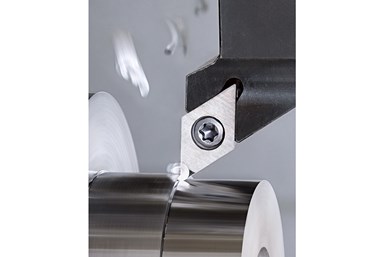Tungaloy’s PCD Turning Inserts for Improved Chip Control
The inserts feature an all-purpose NS chipbreaker for nonferrous applications.

Tungaloy PCD turning insert. Photo Credit: Tungaloy
Tungaloy’s PCD turning inserts now feature a 3D NS chipbreaker which is designed to provide chip control in nonferrous applications for improved productivity.
The inserts were developed to address the issue of long, continuous chips which are generated during the machining of aluminum or copper alloy parts with a conventional PCD insert that has no integrated chipbreaking geometry. These long chips can often cause scratching of the machined surface which can diminish productivity and the resulting surface quality.
The 3D chipbreaker is directly engraved on the PCD tip. This enables the generation of short chips during the machining of gummy metals (such as aluminum and copper alloys), thereby significantly reducing machine downtime due to chip associated troubles.
The chipbreaker is designed to cater to a wide cutting depth range — from extremely light up to 2.0-mm (0.079") DOC. This enables a single PCD insert to handle a variety of operations, from roughing to finishing, giving users the benefit of integrating machining processes and reducing insert inventory for improved productivity.
There are 10 new PCD inserts featuring the chipbreaker in the DX110 grade, providing the insert with a secure edge line for a high-quality, mirror-like surface finish, the company says.
Related Content
-
What Is Trochoidal Turning? How Might Shops Benefit From It?
While trochoidal milling might be a more well-known toolpath strategy, trochoidal turning can offer similar benefits such as high material removal rates especially for rough-turning operations.
-
Tool Path Improves Chip Management for Swiss-Type Lathes
This simple change to a Swiss-type turning machine’s tool path can dramatically improve its ability to manage chips.
-
Making Micro Threads
Production of micro threads can be challenging, but using the most suitable tools for a given application can simplify the task.














.png;maxWidth=300;quality=90)

